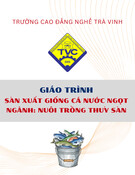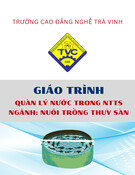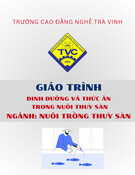
Int.J.Curr.Microbiol.App.Sci (2020) 9(4): 2111-2121
2111
Original Research Article https://doi.org/10.20546/ijcmas.2020.904.254
Effect of Foliar Silicic Acid on Growth, Nutrient Uptake and Blast Disease
Resistance of Finger Millet (Eleusine coracana (L.) Gaertn.)
T. S. Sandhya1*, N. B. Prakash1, A. Nagaraja2 and Y. A. Nanja Reddy3
1Department of Soil Science and Agricultural Chemistry, University of Agricultural Sciences,
Bangalore, India
2Department of Plant Pathology, University of Agricultural Sciences, Bangalore, India
3Department of Plant Physiology, University of Agricultural Sciences, Bangalore, India
*Corresponding author
A B S T R A C T
Introduction
Finger millet (Eleusine coracana (L.) Gaertn.)
[F: Poaceae] also known as Ragi or African
millet ranks fourth in importance among
millets in the world after sorghum (Sorghum
bicolor), pearl millet (Pennisetum glaucum)
and foxtail millet (Setaria italica). Ragi is
grown over 25 countries in the semi-arid and
subtropics of Africa and Asia in about 4 mha,
mainly under rain- fed condition. Under
irrigated condition, the crop has a yield
potential of 3- 4 tha-1. Finger millet has
superior nutritional qualities than that of rice
and is on par with that of wheat (Gupta and
Gupta 2013).
International Journal of Current Microbiology and Applied Sciences
ISSN: 2319-7706 Volume 9 Number 4 (2020)
Journal homepage: http://www.ijcmas.com
Finger millet or ragi is the primary food source for millions of people in tropical dry land
regions of Africa and Asia. Two field experiments were conducted to study the genotypic
variation for silicon accumulation and the effect of foliar applied silicic acid on growth,
nutrient uptake and blast disease resistance of ragi. Study showed a significant varietal
variation for Si accumulation with an average Si content of 1.67 % in the above ground
part. Out of the ten genotypes studied, highest Si content was found in RAU 8 (2.46 %)
and lowest by K 7 (1.03 %). In general, the order of Si accumulation in ragi was followed
as glumes (1.5- 3.9 %) > straw (1.6- 3.1%) > grains (0.18- 0.38%). Foliar application of
Silicic acid increased test weight, grain and straw yield significantly. Significant increase
in grain yield and test weight was observed with 4 ml L-1 foliar silicic acid spray, whereas
2 ml L-1 increased straw yield. Application of 4 ml L-1 foliar silicic acid increased Si
uptake to an extent of 54.6 % over control. There was a significant increase in Ca and P
content in straw and glumes with the application of silicic acid. Reduction in finger blast
was significant with the application of 2 and 4 ml L-1of silicic acid. Reduction in blast
symptoms were to an extent of 69.8 % in GPU 28, 53.75 % in GPU 67 and by 50.4 % in K
7. This is the first time reporting of Si content in finger millet and the response of crop to
foliar Si treatment.
K e y w o r d s
Tropical dry land,
Ragi, Soluble
silicon, Genotypes,
disease tolerance,
Yield parameters
Accepted:
18 March 2020
Available Online:
10 April 2020
Article Info

Int.J.Curr.Microbiol.App.Sci (2020) 9(4): 2111-2121
2112
It is a good source of methionine, cystiene
and lycine. The seed coat of the millet is an
edible component of the kernel, rich in
minerals like calcium and iron. It is also
reported to have phytochemicals, like dietary
fiber (18 %) and polyphenols (2-3%). These
phytochemicals are reported to have many
potential health beneficial properties in
human, such as anti-inflammatory, antiviral,
anticancer and platelet aggregation inhibitory
activity (Chetan and Malleshi, 2007).
The high fiber content (non- starch
polysaccharides) and anti-nutritional factors
in ragi which are known to reduce plasma
glucose level in hyperglycemic persons
(Kumari and Sumathi, 2002). It is an
outstanding subsistence food crop as ragi can
be stored safely for several years without any
insect damage, and has been a traditional
component of farmers’ risk avoidance
strategy in the drought-prone areas.
Moreover, the dry weight ratio of grain to
crop residue is about 3:7, of which latter is an
excellent source of fodder for livestock
especially in dry season. Affected by a variety
of diseases of which blast caused by
Pyricularia grisea Sacc. is a major problem
in ragi.
The beneficial effects of Si on stimulating
plant growth have received increasing
attention, particularly in plants subjected to
both abiotic (e.g. drought, salt and metal
toxicity) and biotic (e.g. plant diseases and
pests) stresses. Species of Poaceae contain 10-
20 times the concentration of Si found in non-
monocotyledonous species (Ma et al., 2002;
Richmond and Sussman, 2003; Hodson et al.,
2005).
However, most of the research work with
regard to Si and plant nutrition focuses on
major crops like rice, wheat, maize and
sugarcane. Though a crop of immense
unexploited potential and tolerant to various
biotic and abiotic stresses, Si accumulation or
its role on growth of ragi has not been
documented. In this regard a basic study was
conducted to investigate the genotypic
variation for Si accumulation in ragi and the
effect of foliar applied Si on growth, nutrient
uptake and blast disease resistance in ragi.
Materials and Methods
The field studies were conducted in the
experimental plots of Zonal Agricultural
Research Station, Bangalore (Central Dry
Zone, Karnataka). Soil was slightly acidic
(pH 5.7), sandy clay in texture, with medium
available Si content (Narayanaswamy and
Prakash, 2009) of 70.5 ppm and high in
organic carbon content 9 g kg-1.
Genotype screening for Si accumulation in
ragi
A field experiment was conducted with 10
popular ragi genotypes (Table.1) viz., GPU
28, GPU 67, GPU 48, GPU 66, Indaf- 9,
Indaf- 5, RAU 8, VL 149, K 7, MR- 2.Of
these genotypes, RAU 8, GPU 28, GPU 48,
MR 2, GPU 66 are resistant; GPU 67 and
Indaf 5 are moderately resistant and K7 is
highly susceptible to blast disease. The
experiment was laid out in randomized block
design, with three replications. All the
recommended management practices were
followed and major nutrients were applied at
the rate of @ 50: 40: 25 Kg N, P2O5, K2O ha-
1. The sources for N, P and K were urea,
single super phosphate and potassium
chloride respectively. Plant sampling was
done at harvest. Grains, glumes and straw
were separated and dried at 70 oC until it
reached constant weight. The dry matter was
powdered and acid digested (7ml HNO3: 2ml
H2O2: 1ml HF) at 150 oC in a microwave.
Digested samples were used for the
determination of Si content, as described by
Ma et al., (2002).

Int.J.Curr.Microbiol.App.Sci (2020) 9(4): 2111-2121
2113
To study the effect of silicic acid on growth,
nutrient uptake and blast disease resistance
Another field experiment was conducted with
three ragi genotypes, which varied in the level
of resistance to blast disease; GPU 28
(resistant), GPU 67 (moderately resistant) and
K 7 (highly susceptible). The experiment was
set up in randomized block design with three
replication as a 3 x 3 factorial, which included
three levels of silicic acid (0, 2 and 4 ml L-1)
and three genotypes.
Concentrated soluble silicic acid (OSAB3 ®)
obtained from Silife Ltd., Leusden, The
Netherlands, was used for spraying at 21 and
36 days after sowing. This silicon formulation
contained 2 % Si as silicic acid, 1.2 % K as
KCl and 0.8 % B as H3BO3.
Observations like plant height and number of
tillers, peduncle length, test weight, grain and
straw yield were recorded. Since the
occurrence of the disease was common in
Kharif season (June- August), the crop was
allowed to have natural disease incidence.
Disease incidence for finger blast in all the
nine treatments was assessed using standard
percentage scale method.
For elemental analysis, straw and heads were
harvested from each plot separately at
maturity and hand threshed to separate grain
and glumes. Collected samples were acid
digested and analyzed for various nutrients.
Statistical analysis
Data obtained were analyzed by ANOVA
using SPSS software. Statistical differences
among treatments were determined using least
significant difference at 0.05 probability level.
Disease incidence score was correlated with
levels of silicic acid applied to study the
effect of Si on blast resistance in Ragi.
Results and Discussion
Genotypic variation in ragi for Si
accumulation
The study showed significant variation for Si
accumulation between the ragi genotypes.
Average Si accumulation in the above ground
parts (Fig. 1), of different genotypes followed
the trend, K7 < GPU 67 ≤ Indaf 9 = MR 2 ≤
GPU 28 = Indaf 5 ≤ GPU 66 ≤ GPU 48 ≤ VL
149 < RAU 8, with an average Si content of
1.67 %. In the screened genotypes, highest
accumulation of silicon in the aboveground
biomass (2.46 %) was noticed in RAU 8.
There was a significant variation in the Si
content in different plant parts of ragi with
glumes accumulating higher and grains with
least Si irrespective of all genotypes. The
average content of Si in glumes, straw and
grain were 2.91, 1.87 and 0.23% respectively.
Among the genotypes, Si accumulation for
glumes was low for K 7 (1.46 %) which was
on par with that of GPU 67 (1.62 %) and
highest for RAU 8 (3.93 %). The Si content of
different genotypes in glumes was in the order
of K7 ≤ GPU 67 < Indaf 5 ≤ MR 2 ≤ GPU 28
≤ VL 149 ≤ Indaf 9 ≤ GPU 66 ≤ GPU 48 <
RAU 8 and in straw, Indaf 9 ≤ GPU 48 ≤
GPU 66 ≤ K7 ≤ GPU 67 < MR 2 ≤ GPU 28 <
Indaf 5 ≤ VL 149 < RAU 8. All the genotypes
accumulated very less amount of Si in grains
when compared to that of straw and glumes.
The Si content ranged from 0.14 (K 7) to 0.38
% (RAU 8).
Effect of silicic acid on growth and yield
parameters
There was a significant variation in the plant
height with the application of foliar Si in ragi.
At the time of harvest, plants of GPU 28,
GPU 67 and K 7 treated with 2 and 4 ml L-1
showed a reduction in height than the control
(Table.1).

Int.J.Curr.Microbiol.App.Sci (2020) 9(4): 2111-2121
2114
Although there was increase in tiller number,
it was not significant with the application of 4
ml L-1 of foliar Si. Peduncle length reduced
with the application of 4 ml L-1Si and was
more prominent in GPU 28.
Application of foliar Si increased the grain
yield, test weight and straw yield in all the
genotypes (Table 1). GPU 28 and K 7
responded to both levels of foliar Si
application and showed significant increase in
grain yield at 4 ml L-1 over the control.
Effect of silicic acid on Si, P, Ca nutrition
Application of foliar Si increased the Si
content in all the genotypes (Table.2).
Application of 4ml L-1 of foliar Si obtained
highest Si content (2.45%). Though the Si
accumulation in glumes was highest for GPU
28 in all the treatments, with the increased
application of foliar Si, K- 7 was also able to
accumulate appreciable amount of Si in
glumes. Similar observations were made with
average Si content in straw, the highest being
in GPU 28 (1.98%). The Si content in grains
showed an increase with the application of
foliar Si, but was significant only for K- 7 at
4ml L-1(0.26%). In general, Si content in
grains at 4ml L-1 treatment (0.35 %) was on
par with control treatment in all the
genotypes. There was a gradual increase in Si
uptake with the increased application of foliar
Si. The total crop uptake was about 140.74 kg
ha-1 at 4 ml L-1.
Application of foliar Si increased the Ca and
P content in straw and its uptake significantly
and was highest in 4 ml L-1 in all genotypes
(Table. 3). K 7 showed increase of Ca content
from 0.74 % in control to 1.13 % at 4 ml L-1.
Effect of silicic acid on blast disease
incidence of ragi
Among the genotypes, K 7 was highly
infected with finger blast compared to other
two genotypes. Though the rate of silicic acid
had a significant and linear effect on reducing
finger blast in all the three varieties, the effect
was most conspicuous in K 7. In all the three
genotypes, application of 4 ml L-1 foliar
silicic acid achieved highest control of finger
blast (Fig. 2).
Genotypic variation in ragi for Si
accumulation
The study showed significant variation for Si
accumulation among the ragi genotypes (Fig.
2). Accumulation of Si in the above ground
plant part was found to be in the order of K7
< GPU 67 ≤ Indaf 9 = MR 2 ≤ GPU 28 =
Indaf 5 ≤ GPU 66 ≤ GPU 48 ≤ VL 149 <
RAU 8. Content of Si in the ragi genotypes
varied from 1.1- 2.5 % with an average of
1.67 %. In the screened genotypes, highest
accumulation of Si in the above biomass (2.46
%) was noticed in RAU 8 (Fig. 2). Marschner
(1995) reported that dryland species of
Gramineae, like wheat and sugarcane contain
1-3 % SiO2. Similar results regarding the
variation in Si accumulation in genotypes of
some crop species have been reported;
Japonica rice varieties have higher Si
concentration than indica rice varieties and Si
content in rice straw ranges from 4- 20 %
(Winslow et al., 1997; Hodson et al., 2005).
Concentration of Si in sugarcane shoot varied
with the variety and ranged from 0.64 to 1.02
% (Deren, 2001).
Perusal of the data showed a significant
difference in accumulation of Si among
glumes, straw and grain of ragi. Highest Si
accumulation was in the glumes (2.91 %),
followed by straw (1.87%) and least in grains
(0.23 %) irrespective of all genotypes. The Si
content of different genotypes in glumes was
in the order of K7 ≤ GPU 67 <Indaf 5 ≤ MR
2 ≤ GPU 28 ≤ VL 149 ≤ Indaf 9 ≤ GPU 66 ≤
GPU 48 < RAU 8 and in straw,Indaf 9 ≤ GPU
48 ≤ GPU 66 ≤ K7 ≤ GPU 67 < MR 2 ≤ GPU
28 <Indaf 5 ≤ VL 149 < RAU 8 (Fig. 2).

Int.J.Curr.Microbiol.App.Sci (2020) 9(4): 2111-2121
2115
Similar to glumes of ragi with an average Si
content of 2.91%, Hodson and Sangster
(1988) reported high silicification in the
inflorescence bract of wheat (lemma and
glumes) especially in the outer epidermal
walls. Also in barley, Si content in grains
ranged from 0- 0.38 % and more than 80 % of
total Si (1.5- 2.7 %) was localized in the hull
(Ma et al., 2003), Gallo et al., (1974) also
noted that rice, oat, rye and wheat seed coat
accumulated most of the silica and the grains
least. After the uptake, Si is transported to the
shoot passively, via the transpiration stream
and is deposited as amorphous silica after the
water evaporates at the termini of the
transpiration stream. In many plants since the
trichomes are the termini and with larger
surface area, are site of prominent
silicification (Epstein 1994, Epstein 2001).
Likewise, glumes are the end of transpiration
stream in ragi and hence high Si accumulation
can be expected in these tissues.
Effect of foliar Silicic acid on growth and
yield parameters
In the present study plants of GPU 28, GPU
67 and K 7 treated with 2 and 4 ml L-1
showed a reduction in height than the control
(Table. 1). Peduncle length also reduced with
the application of 4 ml L-1Si and was more
prominent in GPU 28. Many researchers
observed that application of Si increased plant
height, leaf area and dry mass of crops under
flooded and even under drought conditions
(Gong et al., 2003; Ma et al., 1989).
Application of foliar silicic acid increased the
grain yield, test weight and straw yield in all
the genotypes (Table.1). GPU 28and K 7
responded to both levels of foliar silicic acid
and showed significant increase in grain yield
at 4 ml L-1 over the control. Prakash et al.,
(2011) also noticed a significant increase in
straw and grain yield in rice with foliar silicic
acid over control. Though many studies reveal
the benefits of Si in crop yield, most of them
were with soil applied Si (Singh et al., 2006;
Ma et al., 1989).
It is possible that, the reduction in the plant
height might have improved the erectness of
the plant and improved canopy structure
during the grain filling stage and thereby
promoted the translocation of photosynthates
to the grains and increased 1000 seed weight
(Table.1). Silicon is reported to improve the
erectness of leaves and plant architecture
thereby enhancing photosynthetic efficiency
(Epstein 1994, Hattori et al., 2005). It has also
been reported to be effective in preventing
lodging in rice by increasing the thickness of
the culm wall and the size of the vascular
bundles thereby enhancing the strength of the
stem (Prakash et al., 2011; Korndorfer et al.,
2004).
Effect of silicic acid on Si, K, P, Ca
nutrition
Foliar application of silicic acid increased the
Si content in all the genotypes
(Table.2).Application of 4ml L-1 of Silicic
acid recorded highest Si content (2.45 %).
Though the Si accumulation in glumes was
highest for GPU 28 in all the treatments, with
the increased application of foliar Silicic acid,
K 7 was also able to accumulate appreciable
amount of Si in glumes (80 % increase at 4ml
L-1 over control). Similar observation was
made with average Si content in straw, the
highest being in GPU 28 (1.98 %). The Si
content in grains increased with the
application of silicic acid, but was significant
only for K 7 at 4ml L-1 (0.26%). There was a
gradual increase in Si uptake with the
increased foliar application of silicic acid. The
total crop uptake was about 140.74 kg ha-1 at
4 ml L-1 which was about 54.6 % increase
over control (91.04 kg ha-1). Buck et al.,
(2008) and Guevel et al., (2007) reported that

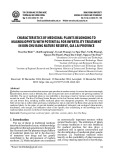
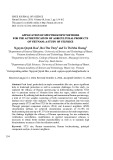
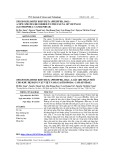
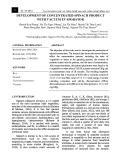
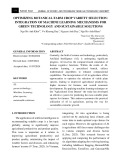
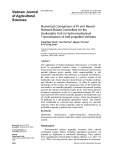
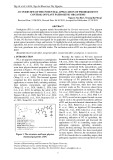
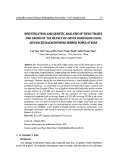
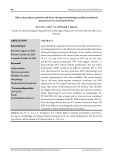
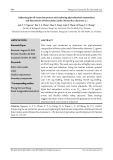




![Giáo trình Sản xuất giống tôm nước lợ, mặn (Trung cấp/Cao đẳng) - Trường Cao đẳng nghề Trà Vinh [Mới nhất]](https://cdn.tailieu.vn/images/document/thumbnail/2025/20251115/kimphuong1001/135x160/76031763179346.jpg)

